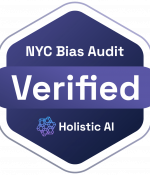AI Recruitment Software
No longer just a buzzword.
AI can help you find and hire the right candidate for every role

How does AI machine learning work at Vervoe?
We use three different models that measure candidate skills and predict job performance.
The How Model works across all questions, the What Model is question-specific, and the Preference Model is employer or role-specific. Here’s more information on how each works.
How Model
Tracks and analyzes the way a candidate interacts with your assessment.
What Model
Analyzes the candidates responses and benchmarks them against millions of others.
Preference Model
Train our AI to understand what a great answer looks like to you and your preferences
How Model
See them do the job
The How Model tracks and analyses the way a candidate interacts with your assessment.
This model assesses interactions such as: How long do they take to complete the assessment? Do they scroll back to a previous question? Do they consistently type or are there long pauses? Do they click away and come back?
Example
This model grades how a candidate works and would be the same as you standing behind the candidate watching them complete the assessment.
The How Model is the first of the three models to provide a score for each of your candidates.
What Model
AI that grades like a human
The What Model analyzes the content of the candidates' responses and benchmarks them against millions of other responses. Through natural language processing candidates' responses are viewed looking for words, phrases, and sentiments that accurately reflect the outcomes required.
Example
If you’re hiring a Call Centre Agent you might be looking for someone with skills like attention to detail and empathy.
This model processes thousands of responses quickly looking for certain words or sentiments that reflect these values accurately.
The What Model uses existing blind data sets, new candidate data, and user input in the form of correct answer samples.
Preference Model
Your own personalized AI model
The Preference Model uses the Naive Beyes method to predict probability. This model requires input from the user to train it to understand what the scale of bad to good answers look like for their specific use case.
This method uses a model called ‘iterative’ where a user blindly grades a set of candidate responses to individual questions giving a score from 0-10. The set of questions that are exposed for the user to grade are the furthest apart from each other. This scoring feedback teaches the AI to value the things you value such as correct spelling or positive sentiment.
Example
If a user grades one response as a 10 our model will then look for an answer that appears to be completely different to see how you score that answer.
This variation in responses helps the model quickly identify and plug the gaps in between the potential score ranges to accurately grade all candidates with your preferences in mind.
How we combat bias
At Vervoe, we understand that machine learning can be susceptible to human hiring bias being introduced through the dataset. For example, if machine learning learns from biased signals like knowing whether an applicant is male or female, then the outcomes will have bias.
To prevent this from occurring at Vervoe, we started with a clean dataset that we built up over two years. During this period, we obtained information from real candidates applying for real jobs and being graded by real employers. To further combat bias, we adopted the following:
No identifying information
Our models are blind to anything that could potentially create bias. We remove personal identifying information like gender, ethnicity, or background from the assessment process. This ensures that candidates are assessed based solely on their skills and knowledge.
Always on monitoring
We monitor manual grading to ensure data integrity. If manually graded responses show a clear bias toward the mention of certain keywords, we can detect the drop in score and flag it while removing it from our learning set.
Human approach
We believe it’s a huge responsibility to develop a system that decides if someone gets hired. Our approach is to question what the AI is judging candidates on. Would we want to be judged that way? If not, then we don’t include it in our data.
Take the guesswork out of hiring
Our platform enables you to test the job ready skills of every applicant and then automatically review, grade and rank them, through our AI, based on how well they perform tasks specific to your role.
Hire efficiently with a smart assessment system
Hiring the right candidate is critical, and Vervoe’s AI-powered assessment system makes it easier and faster. Our smart system is designed to streamline your hiring process by providing personalized grading, candidate scorecards, detailed rankings, and powerful analytics. Here’s how our system works for you:
Personalized grading
Vervoe tailors assessments to match the unique requirements of each role. At the end of the test, AI grades candidates based on their performance in ways that directly relate to the specific job, ensuring that the evaluation process is both accurate and relevant. The system also identifies correct answers based on your company’s standards, scoring candidates accordingly.
Candidate scorecards
Our system generates comprehensive scorecards that give you a clear picture of each candidate’s strengths and areas for improvement. These scorecards allow you to make data-driven decisions, saving you time and helping you compare candidates more effectively.
Detailed ranking
Vervoe’s AI ranks candidates according to their performance on the assessment, empowering you to locate top talent quickly. This eliminates guesswork and speeds up your entire hiring process.
AI assessment builder
Vervoe’s AI Assessment Builder allows you to create customized assessments in minutes. All you need to do is upload a job description or enter a job title, and the AI identifies key skills and suggests validated questions, generating a tailored assessment that meets your specific hiring needs.




VERVOE’S AI
Frequently asked questions
Vervoe uses three specialized models, the How, What, and Preference Models, to assess candidates’ skills, behaviors, and fit for a role. The How Model tracks the way candidates interact with assessments, while the What Model analyzes the content of their responses. The Preference Model learns your specific preferences for what constitutes a strong answer, ensuring that the AI aligns with your expectations and grading style.
AI grading starts to review candidate responses as soon as they are submitted. The first model to grade is the How Model and then the What Model. Sometimes due to the complexity of assessment questions and the volume of candidates final results might not be displayed in the platform for up to a few hours.
AI grading starts to review candidate responses as soon as they are submitted. The first model to grade is the How Model, and then the What Model. Sometimes, due to the complexity of assessment questions and the volume of candidates, final results might not be displayed in the platform for up to a few hours.
Vervoe combats bias by removing personal identifiers (such as gender, ethnicity, or background) from the data used to train its models. This ensures that assessments are based solely on skills and knowledge, allowing candidates to be evaluated fairly.
Vervoe’s AI ranks candidates based on their performance on each assessment. The system uses objective metrics, such as the time taken to complete tasks, the accuracy of responses, and the consistency of their performance, to generate a ranked list of candidates. For enterprise clients Vervoe works with each company to understand what “good” looks like to them which informs how the AI will score candidates based on their responses.
By automating the candidate assessment process, Vervoe’s AI eliminates manual review of resumes and cover letters. This allows you to focus on the candidates who truly match the required skills, significantly reducing time-to-hire and enhancing overall recruitment efficiency.
Initially, you’ll be asked to blindly score a small portion of candidate responses to individual questions in your assessment. We need around 20 graded responses to start optimizing your assessment for your own tailored needs. Obviously, the more you grade, the more we understand about you, but we’re aiming to get about five grades from you across the spectrum of 1–10.
If you update questions to change the new correct answer after some of your candidates have already taken an assessment, their score will recalculate, taking into account the assessment updates to give them a new grade.



